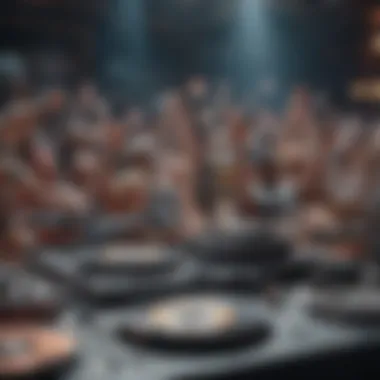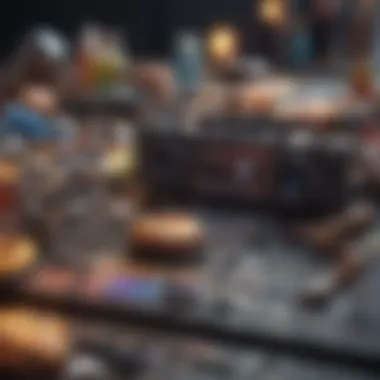Unpacking the Cultural Impact of 90s Party Music


Intro
The 1990s marked a significant period in music history, characterized by a vibrant party culture and a distinct soundscape. This era saw a fusion of genres that catered to a youthful audience seeking freedom and self-expression. 90s party music encapsulates this spirit, encompassing various styles such as hip-hop, dance, eurodance, and pop. Each of these genres contributed to the party atmosphere that defined the decade, influencing not only social gatherings but also the future trajectory of music.
In this exploration, we will dissect the symbolism and lasting impact of 90s party music. We will investigate its roots, characteristic sounds, and cultural significance. Furthermore, we will analyze the artists who shaped this movement and the societal contexts that nurtured its evolution. This nuanced understanding provides insight into how the music of the 1990s continues to resonate with contemporary artists and audiences alike.
Artist Profile
Biography and Background
The 90s birthed several key figures in party music. Artists such as Spice Girls, MC Hammer, and Daft Punk became icons, each contributing uniquely to the sound of the decade. Their backgrounds and trajectories varied, yet each shared a common goal of connecting with a generation through relatable lyrics and infectious beats.
For example, the Spice Girls emerged from London, focusing on themes of female empowerment and friendship. Their formation was a response to the desire for positive representation of women in music. Conversely, MC Hammer from Oakland, California, brought rap to mainstream audiences, characterized by his signature dance moves and catchy hooks, making him a household name.
Major Influences and Inspirations
The artists of 90s party music drew inspiration from previous decades. The disco sounds of the 1970s and emerging hip-hop rhythms from the 1980s laid the groundwork for their success. Madonna, as a pioneer of blending pop with dance, influenced many contemporaries and future artists. Likewise, the energy of funk bands stimulated the rhythm and beats that were essential during this time.
Understanding these influences is crucial. They shaped not just song composition but also the cultural acceptance of diverse music forms. The accessibility of music through radio and television further introduced these sounds to a global audience, illustrating the interconnectedness of cultures.
Song Analysis
Theme and Lyrics Breakdown
Songwriting in 90s party music often revolved around themes of celebration, love, and carefree living. Tracks like “Jump Around” by House of Pain exemplify the high-energy vibe preferred at parties. The lyrics captured an ethos of freedom and enjoyment, resonating with youth culture of the time.
Conversely, songs like the Spice Girls’ “Wannabe” addressed friendship and female solidarity. This duality in themes—celebration versus connection—reflects the broader societal shifts and emotional landscapes experienced during this decade.
Instrumentation and Composition
Musically, 90s party tracks often utilized synthesizers, strong bass lines, and samples from older songs. The production techniques took advantage of emerging technology, allowing for layered instrumentation that created upbeat dance music. Songs like “Around the World” by Daft Punk displayed minimalistic yet catchy compositions that defined the dance genre.
With this variety of tools and technology, the landscape of 90s music expanded significantly. The fusion of different genres—from hip-hop beats to pop melodies—enabled artists to reach wider audiences, setting a precedent for many that followed.
The 90s party music scene not only defined a generation but also paved the way for future music trends, influencing artists and genres that followed.
Historical Context of 90s Party Music
The historical context of 90s party music is critical in understanding its significance in the broader spectrum of music history. This era marked a transformative phase where various socio-cultural factors intertwined with evolving musical styles. Party music of this decade emerged not just as entertainment; it became a reflection of societal changes, technological innovations, and the collective psyche of the youth who were shaped by it.
The Cultural Landscape of the 1990s
The 1990s were characterized by marked changes in society. The end of the Cold War created a climate ripe for exploration and freedom. Young people, in particular, sought places to express themselves, leading to the creation of vibrant party scenes across cities. Rave culture emerged, fueled by a sense of community and the desire for escape through music and dance.
Music festivals and underground raves became essential gatherings, uniting crowds with energetic beats and electrifying atmospheres.
During this time, cultural phenomena such as the rise of hip-hop, indie rock, and electronic music diversified the musical landscape. This period was significant, as the fusion of multiple genres paved the way for the inclusive nature of 90s party music.
Key Musical Influences
Several musical influences coalesced in the 90s to influence party music. First, hip-hop saw a meteoric rise, with artists like Tupac Shakur and The Notorious B.I.G. enriching the party scene. Their beats and lyrical transitions set new standards for groove and cadence.
Meanwhile, electronic dance music started to take root. Subgenres like house and techno thrived, significantly influencing the overall sound. Pioneers like Daft Punk and The Chemical Brothers created tracks that were pivotal in establishing the dance music scene. The rhetoric of the music evolved with the incorporation of samples, creating an auditory tapestry rich in texture.
Technological Advancements in Music Production


The 1990s lent itself to rapid advancements in technology, particularly in music production. The advent of digital recording techniques and affordable synthesizers changed how music was made. Artists now had access to tools that allowed them to craft intricate sounds and intricate beats away from traditional studios.
Software like Pro Tools transitioned music production from analog to digital, allowing producers to manipulate sounds in ways previously thought impossible. Moreover, this accessibility enabled more underground artists to enter the scene, breaking previously held barriers between mainstream and independent musicians.
The increased use of sampling allowed for a creative merging of genres, making tracks both innovative and familiar. This technological leap significantly impacted both the sound and production value in 90s party music, laying groundwork that continues to resonate in contemporary music.
Defining Characteristics of 90s Party Music
Understanding the defining characteristics of 90s party music is crucial for grasping its impact and relevance. This musical genre emerged from diverse cultural influences and marked a significant period in music evolution. It reflected the social mood of the time, emphasizing freedom, self-expression, and community through music. Each element of this music style contributed to its infectious appeal and lasting legacy.
Rhythmic Patterns and Beats
The rhythmic patterns and beats of 90s party music are essential to its danceable nature. Many tracks featured a four-on-the-floor beat, which became synonymous with electronic dance music. This pattern provided a steady, unrelenting rhythm, seeming to invite listeners to the dance floor. In addition to this, unique syncopations and breaks were often used, creating excitement and variation.
Many 90s hits incorporated samples from earlier funk and disco tracks. This blending created a connection between generations of music lovers. Artists like Daft Punk, for instance, utilized iconic beats to craft songs that would become staples in the genre. Having these strong rhythmic foundations helped establish an audible cue for gathering and celebration.
Lyrical Themes and Content
Lyrical themes in 90s party music often revolved around liberation, partying, and euphoric experiences. Lyrics were often simple, repeating catchy phrases that encouraged collective joy. Hits like "Macarena" by Los Del Rio or "Rhythm is a Dancer" by Snap! exemplify how lyrics were designed to be memorable and engaging for large crowds.
The content was also reflective of the societal climate. Many songs celebrated life, love, and the thrill of the night, acting as anthems for youth culture of the time. The carefree themes resonated deeply with listeners, making these songs pivotal in social gatherings and nightlife.
Instrumentation Trends
Instrumentation in 90s party music highlighted innovations in technology and a growing interest in electronic sounds. Keyboards and synthesizers became prevalent, allowing for a wider variety of sounds. Iconic synth lines defined a number of tracks, providing a distinctive edge. Instruments like the MIDI synthesizer facilitated complex layering, creating rich soundscapes that energized listeners.
Besides electronics, sampling became a crucial component. Artists used snippets from various musical genres, including hip-hop and reggae. One notable example is Fatboy Slim’s “Praise You,” which employs clever sampling to fuse different genres seamlessly. This trend not only enhanced creativity but also demonstrated a new approach to music creation.
The 90s party music scene was not just about sound but a cultural moment that merged rhythm and communal energy, shaping the dance music landscape significantly.
Prominent Artists of the 90s Party Scene
The 1990s was a defining decade for party music, a domain that witnessed the emergence of numerous influential artists. These individuals played a pivotal role in shaping the soundscapes of parties, clubs, and festivals, leaving a lasting imprint on the genre. Their contributions helped in creating a vibrant cultural movement that resonated with the youth of the time. Each artist brought unique elements to their music, be it through innovative beats, catchy lyrics, or groundbreaking production techniques. The impact these artists had goes beyond mere entertainment; they fostered a sense of community, identity, and a new way of experiencing music.
DJs and Producers Who Shaped the Era
The DJs and producers of the 90s were instrumental in defining the party music scene. Their ability to blend genres like house, techno, and hip-hop created an electrifying atmosphere on dance floors. Names like Frankie Knuckles and David Guetta, though he rose to fame later, began their journeys during this era.
Frankie Knuckles, known as the "Godfather of House Music," had a profound influence on the transition from disco to house. His tracks, such as "Your Love," became anthems in clubs. Producers like The Chemical Brothers also pushed the boundaries of electronic music with their innovative sounds and remixes.
These artists not only crafted memorable tracks but also pioneered techniques like remixing and sampling, which reshaped how music was produced and consumed. Their work exemplifies the creativity and experimentation that characterized the decade and set the stage for future developments in electronic music.
Iconic Bands and Groups
Iconic bands and groups of the 90s further built the foundation of party music. Groups like the Beastie Boys and Daft Punk brought distinct styles that captivated audiences worldwide. The Beastie Boys' fusion of rap with rock elements made their tracks widespread in both parties and radio airplay. Their song "Sabotage", for example, is still a popular choice in party playlists.
Daft Punk, with their unique aesthetics and sound, introduced a new dimension to electronic music. Albums such as "Homework" showcased an array of styles, including house and techno. Their track "Around the World" became an instant classic, marked by its repetitive lyrics and infectious beats, essential characteristics of party music.
These groups not only produced chart-topping hits but also influenced fashion, style, and the overall party culture.
Emerging Solo Artists
As the 90s progressed, several solo artists began to make their mark in the party scene. Artists like Moby and Madonna, during this time, were blending pop elements with dance music. Moby, with his album "Play", introduced a unique sound that combined electronic beats with vocal samples. Songs like "Porcelain" captured the emotional depth that resonated with many listeners.
Madonna, already a pop icon, reinvented herself through her work with producers like William Orbit. Her album "Ray of Light" featured dance tracks that not only appealed to mainstream audiences but also kept her relevant in the club scene.


This era was marked by the rise of these solo artists who incorporated the evolving sound of electronic music into their identities, demonstrating the versatility of party music.
The 90s party scene was not simply about the music; it was about connection, empowerment, and cultural expression.
Understanding the contributions of these prominent artists helps contextualize the vibrant atmosphere of the 90s party scene and its longstanding influence on current music trends. Their innovations continue to inspire new generations of musicians and enthusiasts.
The Societal Impact of 90s Party Music
The examination of 90s party music reveals a complex interplay between society and culture during a transformative decade. This music was not only a means of entertainment but also a reflection of the social climate and changing habits of the era. Understanding its impact allows for insight into how music shaped community identity, influenced social connectivity, and contributed to evolving cultural norms.
Party Culture and Social Habits
90s party music played a crucial role in shaping party culture. The era embraced a sense of liberation and experimentation. Parties became spaces for people to express themselves and foster connections. Music was central to these gatherings, providing a soundtrack that resonated with collective experiences. Popular genres like techno, house, and hip-hop emerged as essential elements that defined the atmosphere.
- Inclusivity: These gatherings often welcomed individuals from diverse backgrounds. The communal nature of parties weakened societal barriers, promoting a sense of belonging.
- Social Commentary: Many party tracks addressed contemporary issues like freedom, love, and rebellion. The lyrics encapsulated a generation’s voice.
- Rave Culture: The rise of rave parties highlighted alternative social practices. These events often celebrated individuality while emphasizing a shared passion for music.
As people congregated in clubs or other venues, the shared experience created a powerful sense of unity. The trends set in the 90s continue to influence how we understand social gatherings today.
Music Festivals and Live Events
The 90s saw the proliferation of music festivals, significantly impacting societal dynamics. Events such as Lollapalooza and Woodstock '94 starved more than just musical acts. These festivals became cultural milestones, drawing large crowds excited to celebrate through music.
- Diverse Line-ups: Festivals showcased artists across genres, reflecting the eclectic tastes of attendees. This variety encouraged appreciation for different musical styles.
- Community Gathering: Large-scale events reinforced community bonds. They drew fans together, creating friendships tied to shared musical interests.
- Commercial Boom: Festivals paved the way for monetizing live music, leading to today's vast festival landscape where fans are willing to invest in experiences.
Furthermore, these events weren’t just performances; they turned into movements that left a lasting impact on fashion, art, and social activism.
Dance Trends Influenced by Music
Music in the 90s also had direct influence on dance trends. The upbeat nature of tracks sparked a range of dance styles that became cultural artifacts of the era. These dance movements were not merely expressions of rhythm but also conduits for social connections among young people.
- Emergence of Styles: Iconic dance styles like the Macarena and the Running Man became popular, tying social interactions to music.
- Influence on Youth Culture: Many young individuals found identity through these dances, allowing them to express their creativity.
- Global Reach: Dance trends transcended geographical boundaries, showing the universal nature of party music.
Overall, the impact of 90s party music extended beyond entertainment; it forged connections, influenced cultural habits, and nurtured communities. Music served as a powerful tool for expression, reflection, and social interaction.
90s Party Music in a Global Context
The exploration of 90s party music in a global context offers important insights into how this genre transcended cultural and geographical boundaries. During this decade, party music became a unifying force that connected diverse groups through shared experiences and sounds. The vibrant mixture of styles and influences significantly shaped the global music landscape. This section will discuss the various international variations of party music, highlight the processes that led to the globalization of electronic music, and showcase notable cross-cultural collaborations that emerged during this era.
International Variations and Styles
90s party music featured a variety of international styles that reflected the distinct cultural influences of different regions. Genres such as eurodance in Europe juxtaposed with hip-hop in the United States provided unique soundscapes that catered to diverse audiences. Each region brought its own flair, resulting in an eclectic mix of rhythms and melodies.
For instance, the early 90s saw the rise of rave culture in the UK, where acid house and hardcore techno dominated the scene. Artists like Prodigy and The Chemical Brothers exemplified this movement, pushing the boundaries of electronic music.
On the other side of the globe, Latin music had a significant impact on party music, giving rise to genres like merengue and salsa. Artists like Tito Puente and Gloria Estefan brought these sounds to wider audiences, blending traditional rhythms with modern influences.
- Eurodance: Characterized by a blend of house, techno, and Hi-NRG, this genre became a defining sound of 90s parties.
- Hip-Hop: The boom of hip-hop contributed prominent tracks to parties, with artists like Puff Daddy and Salt-N-Pepa becoming staples in the scene.
These international variations not only enriched the party music genre but also highlighted the importance of cultural exchange in shaping musical expressions.
The Globalization of Electronic Music
The 90s marked a turning point in the globalization of electronic music. Accessible production technologies and the rise of the internet facilitated the rapid spread of electronic sounds across borders. This period witnessed an explosion of sub-genres, each merging local traditions with international trends.
With the emergence of platforms, such as radio stations and nightclubs, DJs could mix tracks from various artists, creating unique sets that appealed to public taste. Events like the Love Parade in Berlin served as a showcase for this globalization, attracting thousands from around the world to dance to the same beats.


- Technological Accessibility: Advances in software and hardware democratized music production, allowing more people to create and distribute music.
- Cross-National Influence: Artists collaborated remotely, leading to tracks that blended styles from different cultures, broadening the scope of electronic music.
"The collaboration of artists from varying regions illustrated that music could forge connections that transcended language and cultural barriers."
Cross-Cultural Collaborations
Collaborations across cultures became a hallmark of 90s party music. Artists from traditional backgrounds partnered with electronic music producers to create tracks that resonated globally. This melding of styles promoted deeper cultural appreciation and helped break down barriers within the music industry.
For example, the famous collaboration between Bhujangy and A Tribe Called Quest brought together hip-hop aesthetics with Indian traditional music, resulting in tracks that appealed to both audiences. Similarly, artists such as Moby worked with various musicians worldwide, leading to rich and diversified sonic landscapes.
- Blend of Genres: Global connections allowed for hybrids, such as reggae fusion and samba hip-hop, each reaching new audiences.
- Increased Visibility: Many collaborations gained airplay on international radio stations, leading to wider acceptance of non-Western sounds in the mainstream.
As a result, 90s party music was not just a musical phenomenon but also a cultural movement that reflected the world’s interconnectedness.
Legacy and Influence of 90s Party Music
The legacy of 90s party music is rich and multifaceted. This era produced an array of sounds that not only defined a generation but also laid the groundwork for contemporary music practices. The vitality of the 90s party music scene can be traced in modern genres, where its pulsating rhythms and eclectic styles serve as reference points. The impact of this music goes beyond mere nostalgia; it shapes how artists navigate today’s musical landscape.
Influence on Modern Genres
The sounds of the 90s have permeated various modern music genres. Electronic dance music, hip-hop, and pop frequently pay homage to the 1990s. Tracks from artists like Daft Punk and Calvin Harris echo the techno beats established by 90s DJ icons such as Fatboy Slim and Moby.
- House music: Its rhythmic structure finds its roots in 90s tracks, promoting dance culture worldwide.
- R&B and hip-hop: Artists like Missy Elliott and TLC were influenced by rave culture, incorporating upbeat tempos and bass-heavy drops.
By analyzing the structure and soundscapes of today’s hits, one can easily draw parallels with earlier works. The blend of electronic elements into pop music also suggests a recycling of formulas that were prominent in the 90s.
Resurgence in Contemporary Music
There is a notable resurgence of 90s party music in the current music scene. Many artists are actively revisiting this era, redefining and recontextualizing its sounds. Remixes and samples from iconic 90s tracks often emerge on charts today, showcasing a cyclic nature of influence.
- Current charts: Look at well-known artists like Dua Lipa, who often channel 90s vibes in her music.
- Live performances: DJ sets featuring retro hits draw crowds seeking an authentic experience of past party culture.
"Genres evolve, yet they often circle back to their roots. The 90s party music scene is an undeniable touchstone for today’s artists." This highlights how the rhythmic vigor and catchy choruses continue to resonate.
Nostalgia and Its Cultural Significance
Nostalgia plays a pivotal role in the ongoing influence of 90s party music. For listeners who grew up in that era, the music evokes fond memories and cherished moments. It connects people to their past, reigniting the joy of dancing in clubs and at parties.
- Cultural events: Nostalgic tours and themed parties showcase 90s music, promoting a communal experience.
- Merchandising: Collectibles and fashion from that decade are re-emerging, tapping into the desire for connection.
The cultural significance of nostalgia reveals how deeply ingrained 90s party music is in collective memory. As contemporary artists recognize this sentiment, they craft sounds that not only appeal to older generations but also captivate younger audiences who seek to understand the roots of today’s music.
The influence of the 90s party music scene continues to be felt today. Its rhythms, cultural contexts, and nostalgia remain integral to understanding the current musical framework.
End
The conclusion section of this article serves to encapsulate the significant themes and findings related to 90s party music. It brings together various threads discussed in the earlier sections, providing a concise reflection on their relevance.
Summary of Key Points
The exploration of 90s party music reveals several essential aspects:
- Cultural Reflection: The genre acted as a mirror to the culture of the era, intertwined with youth identity, clubbing, and social interactions.
- Musical Innovation: Advances in technology facilitated new sounds and production techniques, shaping the characteristic rhythms and beats of the time.
- Influential Figures: Iconic artists and DJs such as Daft Punk and The Chemical Brothers played pivotal roles in shaping the soundscape and have influenced generations of musicians since.
- Global Perspective: The genre was not limited to one geographic area; rather, it saw various interpretations and styles emerge internationally.
- Lasting Legacy: Modern music continues to draw inspiration from the melodies and rhythms established in the 90s, evidencing the ongoing significance of this period in music history.
Future Directions in Music Study
The study of 90s party music offers avenues for future research and discussion. Here are some potential directions:
- Cross-Disciplinary Analysis: Scholars could look at the intersection of music with other social phenomena, including fashion and politics during the 90s.
- Technological Studies: Investigating how production tools of the 90s, like the MIDI and sampling technology, have evolved and influenced today's music.
- Cultural Impact Studies: More focused research on how this music shaped contemporary youth culture and party scenes worldwide.
- Nostalgia in Music: Understanding why 90s music is experiencing a resurgence today, examining aspects of nostalgia and memory in musical appreciation.
In summary, while 90s party music was a product of its time, its implications, symbols, and influences create a fertile ground for ongoing scholarly discourse, ensuring its relevance in both historical and contemporary contexts.







